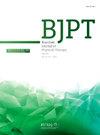土耳其版老年人下肢功能量表的效度和信度研究
IF 3.2
3区 医学
Q1 ORTHOPEDICS
引用次数: 0
摘要
世界卫生组织的残疾和健康模型涉及基于国际功能、残疾和健康分类(ICF)的活动限制。下肢功能量表(LEFS)是在ICF框架下开发的,旨在将下肢的功能状态定义为老年人健康、活动和参与的重要指标。目的分析老年人土耳其语版LEFS (LEFS- t)的心理测量特征。方法选取214例老年人,采用LEFS-T、五次坐立测试(FTSTS)、国际跌倒效能量表(FES-I)进行研究。采用Cronbach's alpha内部一致性系数(ICC)、spearman相关分析和验证性因子分析(CFA)评估信度和效度。结果slefs - t量表具有良好的内部一致性(0.93)、良好的信度(ICC = 0.98)、良好的结构和判别效度,无下限效应和上限效应。CFA结果处于优异水平(近似均方根误差= 0.004,拟合优度= 0.974,比较拟合指数= 0.991,非归一化拟合指数= 0.990)。在构念效度方面,LEFS-T与FTSTS有较好的相关性(r = -0.555, p <;0.001)和FES-I (r = -0.756, p <;0.001)。结论土耳其版LEFS量表具有良好的心理测量特性,可用于评估无下肢肌肉骨骼疾病的老年人的功能能力。LEFS-T量表是一种有效、可靠且易于应用的自我报告量表,可用于未来的研究中评估和跟踪下肢功能能力的变化、力量问题和跌倒预防干预措施。本文章由计算机程序翻译,如有差异,请以英文原文为准。
Validity and reliability study of the Turkish version of the Lower Extremity Functional Scale in elderly adults
Background
The World Health Organization's disability and health model implicates activity limitation based on the International Classification of Functioning, Disability, and Health (ICF). The Lower Extremity Functional Scale (LEFS) was developed in the framework of the ICF to define the functional status of the lower extremities as an important indicator of the health, activity, and participation of the elderly.
Objective
To analyze the psychometric properties of the Turkish version of LEFS (LEFS-T) in older individuals.
Methods
A total of 214 older individuals were included in the study and the LEFS-T, Five-Times-Sit-to-Stand Test (FTSTS), and Falls Efficacy Scale-International (FES-I) were administered. Reliability and validity were evaluated according to Cronbach's alpha internal consistency coefficients (ICC), spearman correlation analysis, and confirmatory factor analysis (CFA).
Results
LEFS-T was feasible, had good internal consistency (0.93), good reliability (ICC = 0.98), good construct, and discriminant validity, and showed no floor or ceiling effects. The results of CFA are at excellent levels (Root Mean Square Error of Approximation = 0.004, Goodness of Fit = 0.974, Comparative Fit Index = 0.991, Non-Normed Fit Index = 0.990). For construct validity, LEFS-T showed a better correlation with FTSTS (r = -0.555, p < 0.001) and FES-I (r = -0.756, p < 0.001).
Conclusion
The Turkish version of LEFS has good psychometric properties to evaluate functional capacity in older adults without lower extremity musculoskeletal disorders. LEFS-T can be used in future studies to evaluate and follow changes in lower extremity functional capacity as well as strength problems and fall prevention interventions, as it is a valid, reliable, and easily applicable scale with self-report.
求助全文
通过发布文献求助,成功后即可免费获取论文全文。
去求助
来源期刊
CiteScore
6.10
自引率
8.80%
发文量
53
审稿时长
74 days
期刊介绍:
The Brazilian Journal of Physical Therapy (BJPT) is the official publication of the Brazilian Society of Physical Therapy Research and Graduate Studies (ABRAPG-Ft). It publishes original research articles on topics related to the areas of physical therapy and rehabilitation sciences, including clinical, basic or applied studies on the assessment, prevention, and treatment of movement disorders.

 求助内容:
求助内容: 应助结果提醒方式:
应助结果提醒方式:


